Lemon Pie |
||||||||||||||||
 |
 |
|||||||||||||||
Knitted jumper in DROPS Karisma. Piece is knitted top down with round yoke and Nordic pattern. Size: S - XXXL Knitted hat in DROPS Karisma. Piece is knitted with Nordic pattern fold in rib.
DROPS 195-10 |
||||||||||||||||
|
EXPLANATION FOR THE PATTERN: ---------------------------------------------------------- INCREASE/DECREASE TIP: To calculate how to increase evenly, use the total number of stitches on row (e.g. 96 stitches) and divide stitches by number of increases to be done (e.g. 32) = 3. In this example increase by making 1 yarn over after every 3rd stitch. On next round knit yarn overs twisted to avoid holes. When decreasing, knit every 2nd. and 3rd. stitch together. ELEVATION (in back of neck): Skip this paragraph if you do not want an elevation. Insert 1 marker at beginning of round = mid back. Begin from right side with light pearl grey and knit 15-16-17-18-19-20 stitches past marker, turn, tighten yarn and purl 30-32-34-36-38-40. Turn, tighten yarn and knit 45-48-51-54-57-60, turn, tighten yarn and purl 60-64-68-72-76-80. Turn, tighten yarn and knit 75-80-85-90-95-100, turn, tighten yarn and purl 90-96-102-108-114-120. Turn piece, tighten yarn and knit until mid-back. Then work YOKE as explained in pattern. KNITTING TIP: To avoid the knitting tension to tighten when working pattern, it is important not to tighten the strands on back side of piece. Use a larger needle size when working pattern if needed. It is important to keep the knitting tension vertically otherwise the yoke on jumper will be too short and the armholes too small! PATTERN: Jumper: See diagrams A.1 to A.6. Choose diagram for your size (applies to A.1, A.3, A.4, A.5 and A.6). Work the entire pattern in stocking stitch. Hat: See diagram A.7. Work the entire pattern in stocking stitch. DECREASE TIP (applies to mid under sleeves): Begin 2 stitches before stitch with marker thread, knit 2 together, knit 1 (stitch with marker thread), knit 2 twisted together (= 2 stitches decreased). ---------------------------------------------------------- START THE PIECE HERE: ---------------------------------------------------------- JUMPER - SHORT OVERVIEW OF THE PIECE: Neck edge, yoke and body are worked in the round on circular needle, top down. Work sleeves in the round on double pointed needles/a short circular needle, top down. NECK EDGE: Cast on 96-100-104-112-116-124 stitches on circular needle size 3.5 mm with light pearl grey. Knit 1 round. Then work rib in the round (= knit 2/purl 2) for 3 cm. Knit 1 round while increasing 32-34-34-34-34-36 stitches evenly - read INCREASE/DECREASE TIP = 128-134-138-146-150-160 stitches. Switch to circular needle size 4.5 mm. Knit 1 round. Now work an elevation at the back of neck so that yoke is somewhat higher on back piece. This elevation can be skipped, then the neck will be the same front and back - work ELEVATION - read explanation above, or go straight to YOKE. YOKE: Read KNITTING TIP! Work A.1 in the round. REMEMBER THE KNITTING TENSION! When A.1 has been worked, work 2-2-2-2-4-8 rounds in stocking stitch with lemon - AT THE SAME TIME on first round increase 32-34-38-46-50-56 stitches evenly – remember INCREASE/DECREASE TIP = 160-168-176-192-200-216 stitches. Then work A.2 in the round (= 20-21-22-24-25-27 repetitions of 8 stitches). AT THE SAME TIME on every round marked with arrow increase evenly as explained below. On round with arrow-1 increase 40-48-56-56-64-64 stitches evenly = 200-216-232-248-264-280 stitches (there is now room for 25-27-29-31-33-35 repetitions of 8 stitches). On round with arrow-2 increase 32-40-48-48-56-56 stitches evenly = 232-256-280-296-320-336 stitches (there is now room for 29-32-35-37-40-42 repetitions of 8 stitches). On round marked with arrow-3 increase 20-32-32-40-40-48 stitches evenly = 252-288-312-336-360-384 stitches. When A.2 has been worked, work A.3 in the round (= 21-24-26-28-30-32 repetitions of 12 stitches). Continue pattern like this. AT THE SAME TIME on round marked with arrow-4 increase 20-16-16-20-20-20 stitches evenly = 272-304-328-356-380-404 stitches. Then work until last round in A.3 remain. Then work last round as follows: Work 42-46-49-54-59-64 stitches as shown in last row in A.3 (= ½ back piece), slip the next 52-60-66-70-72-74 stitches on 1 stitch holder for sleeve, cast on 8-8-10-10-12-14 new stitches on needle (= in the side under sleeve), work 84-92-98-108-118-128 stitches as shown in last row in A.3 (= front piece), slip the next 52-60-66-70-72-74 stitches on 1 stitch holder for sleeve, cast on 8-8-10-10-12-14 new stitches on needle (= in the side under sleeve) and work the remaining 42-46-49-54-59-64 stitches as shown in A.3 (= ½ back piece). Finish body and sleeves separately. NOW MEASURE THE PIECE FROM HERE! BODY: = 184-200-216-236-260-284 stitches. SIZE S and M: Work A.4 in the round (= 46-50 repetitions of 4 stitches). When A.4 has been worked, work A.5 in the round. AT THE SAME TIME on round with arrow-5 in A.5 increase 16 stitches evenly in both sizes = 200-216 stitches. When A.5 has been worked, work as explained below ALL SIZES! SIZE L: Work A.5 in the round (= 54 repetitions of 4 stitches). AT THE SAME TIME on round with arrow-5 increase 16 stitches evenly = 232 stitches. When A.5 has been worked, work as explained below ALL SIZES! ALL SIZES: Work A.6 in the round (= 50-54-58-59-65-71 repetitions of 4 stitches). Continue pattern like this. AT THE SAME TIME on round marked with arrow-5 in A.6 increase 16 stitches evenly (only applies to size XL, XXL and XXXL and only applies first time A.6 is worked vertically in these sizes) = 200-216-232-252-276-300 stitches on needle. Continue A.6 until piece measures approx. 31 cm from division in all sizes. Knit 1 round with lemon while increasing 52-56-60-64-68-76 stitches evenly = 252-272-292-316-344-376 stitches. Switch to circular needle size 3.5 mm. Work rib in the round with lemon = knit 2/purl 2 for 3 cm. Then loosely cast off with knit over knit and purl over purl but to avoid at tight cast-off edge make 1 yarn over after every 8th stitch at the same time cast off (cast off yarn overs as stitches). Jumper measures approx. 58-60-62-64-66-68 cm from shoulder and down. SLEEVE: Slip the 52-60-66-70-72-74 stitches from stitch holder in one side of piece on double pointed needles or a short circular needle size 4.5 mm and pick in addition up 1 stitch in each of the 8-8-10-10-12-14 new stitches cast on under sleeve = 60-68-76-80-84-88 stitches on needle. Insert 1 marker thread in the middle of the 8-8-10-10-12-14 stitches under sleeve, i.e. insert marker thread in first stitch after the middle, count 29-33-37-39-41-43 stitches, insert 1 marker thread in next stitch (= middle stitch). 29-33-37-39-41-43 stitches now remain on round after last marker thread. Move marker threads upwards when working. Marker thread under sleeve is used later when decreasing and marker thread mid on top of sleeve should be used to count where to begin pattern. READ THE REST OF SLEEVE BEFORE CONTINUING! Work last row in A.3 to finish A.3 the same way as on body. SIZE S and M: Work A.4 in the round (= 15-17 repetitions of 4 stitches), but count outwards from the middle – middle stitch in A.4 (marked with triangle) should fit stitch with marker thread mid on top of sleeve. When A.4 has been worked, work A.5 in the round. After A.5 work A.6 in the round. Repeat A.6 down to rib. SIZE L: Work A.5 in the round (= 19 repetitions of 4 stitches), but count outwards from the middle – middle stitch in A.5 (marked with triangle) should fit stitch with marker thread mid on top of sleeve. After A.5 work A.6 in the round. Repeat A.6 down to rib. SIZE XL, XXL and XXXL: Work A.6 in the round (= 20-21-22 repetitions of 4 stitches), but count outwards from the middle – middle stitch in A.6 (marked with triangle) should fit stitch with marker thread mid on top of sleeve. Continue A.6 down to rib. DECREASE: AT THE SAME TIME when piece measures 2-2-2-2-3-3 cm, decrease 2 stitches mid under sleeve - read DECREASE TIP. Decrease like this every 6-4-2½-2½-2-1½ cm 7-10-13-14-15-16 times in total = 46-48-50-52-54-56 stitches. When sleeve measures approx. 40-39-37-35-34-32 cm from division (shorter measurements in the larger sizes because of longer yoke), knit 1 round with lemon while increasing 2-0-2-0-2-0 stitches evenly = 48-48-52-52-56-56 stitches. Switch to double pointed needles size 3.5 mm. Work rib in the round = knit 2/purl 2 for 5 cm. Cast off with knit over knit and purl over purl but make sure to avoid a tight cast-off edge (if the cast-off edge is tight make 1 yarn over after every 8th stitch while casting off - cast off yarn overs as regular stitches). Sleeve measures approx. 45-44-42-40-39-37 cm from division and down. Work the other sleeve the same way. ---------------------------------------------------------- HAT - SHORT OVERVIEW OF THE PIECE: Worked in the round on circular needle, bottom up. Switch to double pointed needles when needed. HAT: Cast on 132-140 stitches on circular needle size 3 mm with light pearl grey. Work rib in the round = knit 2/purl 2 for 10 cm. Switch to circular needle size 4 mm. Knit 1 round while at the same time decrease 36-36 stitches evenly - read INCREASE/DECREASE TIP = 96-104 stitches. Read KNITTING TIP and work A.7 in the round (= 12-13 repetitions of 8 stitches). REMEMBER THE KNITTING TENSION! When A.7 has been worked, continue in stocking stitch with lemon. When piece measures 24-24 cm, knit 1 round while decreasing 0-2 stitches evenly = 96-102 stitches. Now insert 6 markers in the piece as follows: Insert first marker at the beginning of round, then insert the next 5 marker 16-17 stitches apart. On next round, decrease 1 stitch after every marker by knitting the first 2 stitches together after every marker. Decrease like this on every other round 10-10 times in total and then on every round 2-3 times in total = 24-24 stitches remain. Knit 2 rounds where all stitches are knitted together 2 by 2 on both rounds = 6-6 stitches remain. Cut the yarn and pull it through the remaining stitches, tighten together and fasten. Hat measures approx. 32-33 cm in total from top and down. Fold up half the rib edge. |
||||||||||||||||
Diagram explanations |
||||||||||||||||
|
||||||||||||||||

|
||||||||||||||||

|
||||||||||||||||
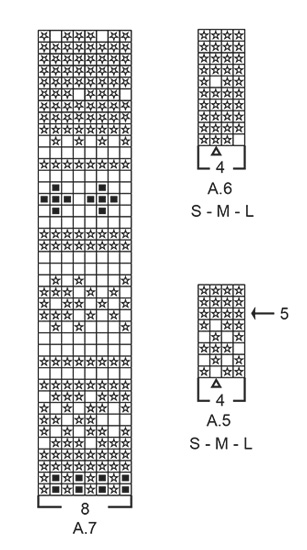
|
||||||||||||||||
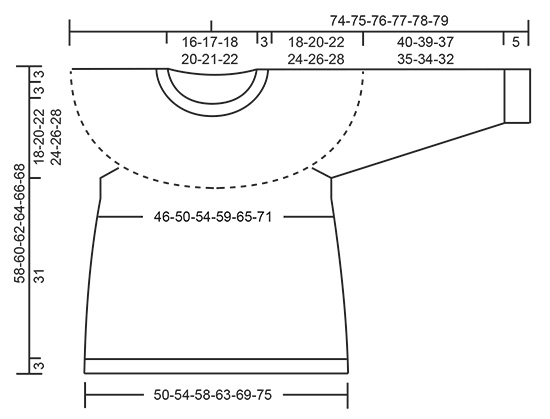
|
||||||||||||||||
|
Have you made this or any other of our designs? Tag your pictures in social media with #dropsdesign so we can see them! Do you need help with this pattern?You'll find tutorial videos, a Comments/Questions area and more by visiting the pattern on garnstudio.com. © 1982-2024 DROPS Design A/S. We reserve all rights. This document, including all its sub-sections, has copyrights. Read more about what you can do with our patterns at the bottom of each pattern on our site. |
||||||||||||||||








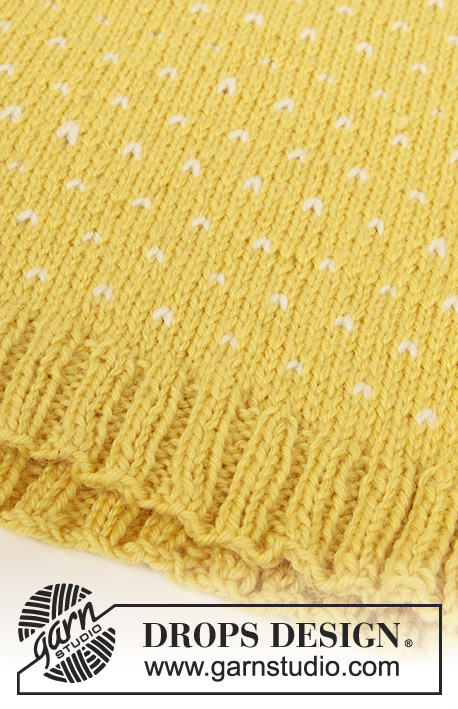
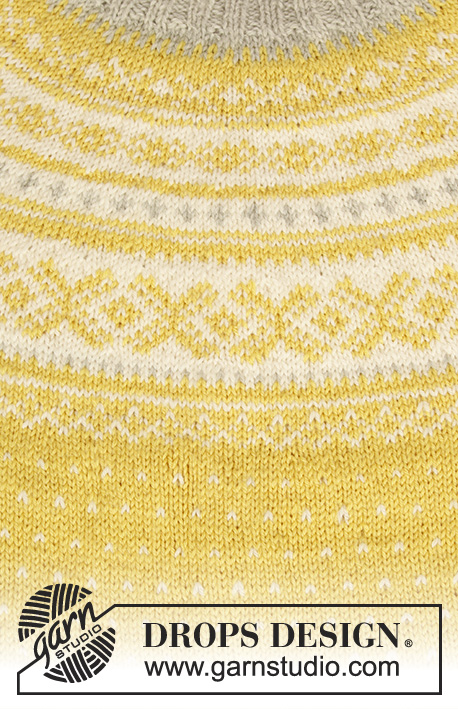



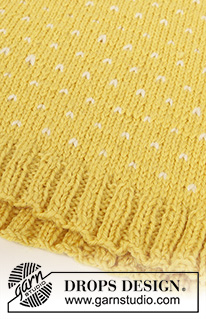























































Comments / Questions (29)
Hi, what size sweater do woman in pictures wear?
20.01.2021 - 01:03DROPS Design answered:
Hi Ruta, There is a measurements sketch at the bottom of all the patterns, so you can choose your size when making any garment. Happy crafting!
20.01.2021 - 07:42Hej, jag söker ett garn som inte kliar. vilket är bäst alpaca eller babymerino? Hur ska jag göra? Om jag tar baby merion, kan jag då gå upp i storlek, ex. göra XL för att uppnå storlek M.
20.01.2020 - 20:36Hej! När jag stickar ärmarna, är det meningen att öka på det varvet med pil, som i resten av tröjan, eller ska man skippa det? Tack för alla fina mönster!
31.07.2019 - 07:05DROPS Design answered:
Hej. Nej på ärmarna ska du inte öka vid pilen. Lycka till!
22.08.2019 - 10:11Ich würde gern dieses Modell in Baby Alpaca/Silk stricken. Wie verändert sich dabei das Strickmuster, bzw. die Maschenzahl bei Aufnahme und Muster? Kann ich einfach das Modell eine Größe größer stricken? Danke im Voraus.
18.06.2019 - 16:05DROPS Design answered:
Liebe Frau Dammann, leider können wir jeder Anleitung nach jedem individuellen Frage anpassen und einzelne Modelle auf individuellen Wunsch hin umrechnen. Wenn sie Hilfe damit brauchen, wenden Sie sich bitte an dem Laden wo Sie die Wolle gekauft haben, dort hilft man Ihnen gerne weiter. Gerne können Sie sich auch von Nordischen Modellen von der Garngruppe A, wie BabyAlpaca Silk inspirieren. Viel Spaß beim stricken!
18.06.2019 - 16:21For the sleeve, size M. Slip 60 stitches from holder yarn (60), pick up an additional one on each of the 8 new stitches under the sleeve (68). "Insert 1 marker thread in the middle of the 8-8-10-10-12-14 stitches under sleeve, i.e. insert marker thread in first stitch after the middle, count 33 stitches, insert 1 marker thread in next stitch (= middle stitch). 33 stitches now remain on round after last marker thread." This is incorrect, isn't it? 68/2 = 34, not 33.
11.03.2019 - 01:41DROPS Design answered:
Dear Cathy, you should have (from beg of round = middle of the 8 new sts cast on): 1 st with marker (= mid under sleeve), 33 sts, 1 st with marker (mid upper sleeve), 33 sts = 68 sts. Happy knitting!
11.03.2019 - 11:16Hi, Cool sweate, but where Information / Explanation for the pattern? Something about: KNITTING TIP and work ELEVATION Thank you
09.02.2019 - 13:52DROPS Design answered:
Dear Verra, the pattern started with some useful explanations/tips for the pattern, then you'll find the written pattern when it says "START THE PIECE HERE". Happy knitting!
11.02.2019 - 08:25Jag stickar nu min andra tröja i den här modellen. Jag gör inte ökningen inför resåren, gjorde det på den första tröjan och det blev helt fel. Förstår heller inte varför eftersom man normalt ökar maskantalet efter resår om man stickar nerifrån.
08.02.2019 - 12:21Hei. I strl. small ser det ut som diagram a3 slutter med to farger. Skal man dele opp til erme og bol mens man strikker mønster?
25.01.2019 - 19:04Hej. Jeg vil høre om det kan passe, at man i str s skal tage ud og sætte masker på snor til ærme på samme tid, mens man strikker mønster og ikke på en pind, hvor man strikker ensfarvet? mvh Pia
13.01.2019 - 16:44DROPS Design answered:
Hei Pia. Det stemmer at du deler til ermer og bol på siste omgangen i A.3. Denne omgangen er ensfarget: hele omgangen strikkes med sitron. God fornøyelse
16.01.2019 - 14:46Klopt het dat er zoveel steken moeten GEMEERDERD worden voor de onderste rand in boordsteek?
31.12.2018 - 13:33DROPS Design answered:
Chris,
Ja, dat klopt. Het patroon heeft een A-lijn en daarom wordt er gemeerderd voor de boord.
01.01.2019 - 19:04